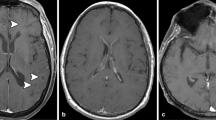Summary
Computed axial tomography has come to be a most useful procedure in the selection, diagnosis, treatment, and follow-up of patients with inflammatory and parasitic lesions of the brain, because it allows a more accurate localization and definition of the histologic nature of lesions. Conventional contrast X-ray studies are not to be abandoned, but they do present a certain risk and do not provide the same degree of accuracy as CAT. Cerebral angiography will have to be carried out when CAT shows pathologic lesions.
Similar content being viewed by others
References
Anderson, J. M., MacMillan, J. J.: Intracranial tuberculoma: An increasing problem in Britain. J. Neurol. Neurosurg. Psychiatry 38, 194–201 (1975)
Asenjo, A., Valladeras, I. I., Fierro, J.: Tuberculomas of the brain: Report of one hundred and fifty-nine cases. Arch. Neurol. Psychiatry (1951)
Costero, I.: Cisticercosis del sistema nervioso. Tratado de anatomía patologica, pp. 1485–95, México: Atlanta 1946
Dastur, H. M., Desai, A. D.: A comparative study of brain tuberculomas and gliomas based upon 107 case records of each. Brain 88, 375–396 (1975)
Dixon, H. B. F., Hargraves, W. G.: Cysticercosis (Taenia solium): A further 10 years clinical study covering 284 cases. Q. J. Med. 13, 107–121 (1944)
Dixon, H. B. F., Lipscomb, F. M.: Cysticercosis: An analysis and follow-up of 450 cases. Privy Council, Medical Research Council Special Report No. 299, pp. 1–57. London: HMSO 1961
Norman, D., Rosenblum, M., Hoff, J., Newton, T. H.: Infections and infestations. (Personal communication)
Paxton, R., Ambrose, J.: The EMI Scanner. A brief review of the first 650 patients. Br. J. Radiol. 47, 530–565 (1974)
Ramamurthi, B.: Experiences with tuberculomas of the brain. Indian J. Surg. 18, 452–455 (1956)
Ramamurthi, B.: Surgery in tuberculoma of the brain. Excerpta Med. (First International Congress of Neurological Surgery) 1957, 93–94
Rodriguez-Carbajal, J., Palacios, E., Azar-Kia, B., Churchill, R.: Radiology of cysticercosis of the central nervous system including computed tomography. Radiology 125, 127–131 (1977)
Zimmerman, R. A., Patel, S., Bilaniuk, L. T.: Demonstration of purulent infections by computed tomography. Am. J. Roentgenol. 127, 155–165 (1976)
Wilkinson, H. A., Ferris, E. J., Muggia, A. L., et al.: Central nervous system tuberculosis: A persistent disease. J. Neurosurg. 34, 15–22 (1971)
Author information
Authors and Affiliations
Rights and permissions
About this article
Cite this article
Rodríguez, J.C., Gutiérrez, R.A., Valdés, O.D. et al. The role of computed axial tomography in the diagnosis and treatment of brain inflammatory and parasitic lesions: Our experience in Mexico. Neuroradiology 16, 458–461 (1978). https://doi.org/10.1007/BF00395332
Issue Date:
DOI: https://doi.org/10.1007/BF00395332




